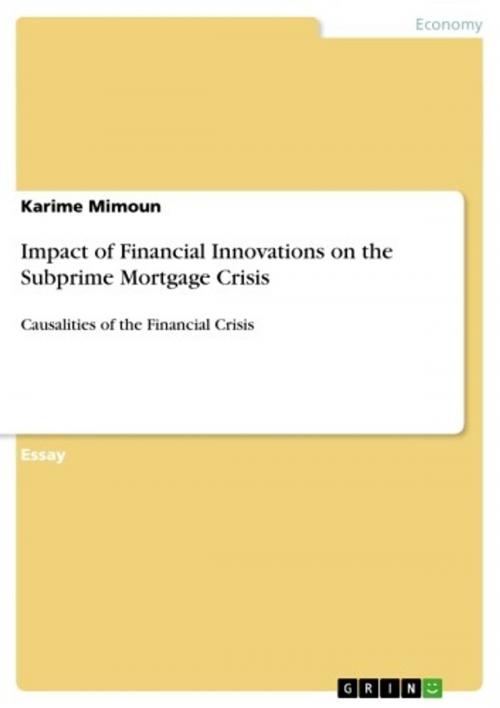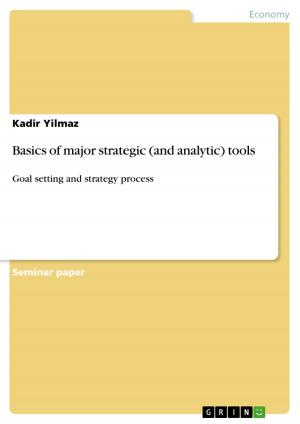Impact of Financial Innovations on the Subprime Mortgage Crisis
Causalities of the Financial Crisis
Business & Finance, Finance & Investing, Finance| Author: | Karime Mimoun | ISBN: | 9783640574773 |
| Publisher: | GRIN Publishing | Publication: | March 24, 2010 |
| Imprint: | GRIN Publishing | Language: | English |
| Author: | Karime Mimoun |
| ISBN: | 9783640574773 |
| Publisher: | GRIN Publishing |
| Publication: | March 24, 2010 |
| Imprint: | GRIN Publishing |
| Language: | English |
Essay from the year 2009 in the subject Business economics - Investment and Finance, grade: First, University of the West of England, Bristol, course: Financial Instruments; Course: MSc Finance, language: English, abstract: Previous financial crises were generally macroeconomic nature, frequently caused by mismanagement of governments. In contrast, the current financial crisis is the result of microeconomic misbehaviour of many market participants. The macroeconomic conditions played rather a by-product of the subprime crisis (Park, 2009); which resulted in a collateral crisis, liquidity crisis and finally in a central banking crisis (The Economist, 2007). This paper investigates the correlation between financial innovations and the credit crunch, how financial innovations developed and which other factors contributed to the credit crunch. The first part deals with the price bubble and their creation through high financial leverage and securitization. In the next step, the focus is on involved financial institutions like rating agencies and structured investment vehicles and their impact and eventually, how the price-bubble burst as well as absolution arguments of financial innovations. Ex-ante clarifications; according to Allen et al. (2008); a financial crisis is a rapid financial disintermediation due to financial panic. Characteristics are a flight to quality where savers liquidate assets in financial institutions due to a sudden increase in their perceived risk, moving their savings to safer assets like foreign currencies and foreign bonds in open economies or to currency, gold and government bonds in closed economies. This results finally in bank failures, stock market crashes and currency crises; which occasionally leading to deep recessions. Regarding the set out question Tufano (2002) defines financial innovations as, 'the act of creating and then popularizing new financial instruments as well as new financial technologies, institutions and markets.'
Essay from the year 2009 in the subject Business economics - Investment and Finance, grade: First, University of the West of England, Bristol, course: Financial Instruments; Course: MSc Finance, language: English, abstract: Previous financial crises were generally macroeconomic nature, frequently caused by mismanagement of governments. In contrast, the current financial crisis is the result of microeconomic misbehaviour of many market participants. The macroeconomic conditions played rather a by-product of the subprime crisis (Park, 2009); which resulted in a collateral crisis, liquidity crisis and finally in a central banking crisis (The Economist, 2007). This paper investigates the correlation between financial innovations and the credit crunch, how financial innovations developed and which other factors contributed to the credit crunch. The first part deals with the price bubble and their creation through high financial leverage and securitization. In the next step, the focus is on involved financial institutions like rating agencies and structured investment vehicles and their impact and eventually, how the price-bubble burst as well as absolution arguments of financial innovations. Ex-ante clarifications; according to Allen et al. (2008); a financial crisis is a rapid financial disintermediation due to financial panic. Characteristics are a flight to quality where savers liquidate assets in financial institutions due to a sudden increase in their perceived risk, moving their savings to safer assets like foreign currencies and foreign bonds in open economies or to currency, gold and government bonds in closed economies. This results finally in bank failures, stock market crashes and currency crises; which occasionally leading to deep recessions. Regarding the set out question Tufano (2002) defines financial innovations as, 'the act of creating and then popularizing new financial instruments as well as new financial technologies, institutions and markets.'















